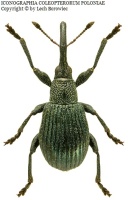Підтримуємо Вільну Україну
 We Support Free Ukraine
We Support Free Ukraine

Biodiversity Map
Taxa

-
Arthropodaphylum
Click to switch
to select orders
and filters > -
Hexapodasubphylum
Click to switch
to select orders
and filters > -
Insectaclass
Click to switch
to select orders
and filters > -
Coleopteraorder
Click to set
as the main taxon
and as a base
← of the left panel > -
Polyphagasuborder
Click to set
as the main taxon
and as a base
← of the left panel > -
Cucujiformiaseries
Click to set
as the main taxon
and as a base
← of the left panel > -
Curculionoideasuperfamily
Click to set
as the main taxon
and as a base
← of the left panel > -
Apionidaefamily
Click to set
as the main taxon
and as a base
← of the left panel > -
Apioninaesubfamily
Click to set
as the main taxon
and as a base
← of the left panel > -
Oxystomatinitribe
Click to set
as the main taxon
and as a base
← of the left panel > -
Oxystomatinasubtribe
Click to set
as the main taxon
and as a base
← of the left panel > -
Hemitrichapiongenus
Click to set
as the main taxon
and as a base
← of the left panel > -
Tinocybasubgenus
Click to set
as the main taxon
and as a base
← of the left panel >
species:
Hemitrichapion (Tinocyba) reflexum
PL
YES
name status: valid name
BioMap ID: 1027132
taxon code: 4941
taxonomy checked: YES
Data on distribution in Poland

Statistics
- Records: 139
- Publications: 48
- Collections: 5
- Publication authors: 30
- Illustrations (iconography): 1
- Photos (specimen/observation): lacking
Taxon description
Gatunek występujący głównie w południowej części Europy, lokalnie i rzadko spotykany w Europie Środkowej, notowany ponadto z zachodniej części Afryki Północnej oraz zachodniej i środkowej Azji. W Polsce występuje prawdopodobnie w całym kraju prócz wyższych partii górskich, ale z wielu krain brak jeszcze udokumentowanych danych o jego stanowiskach. Zasiedla tereny suche i dobrze nasłonecznione, zwłaszcza gleby wapienne. Żyje na sparcecie siewnej — Onobrychis viciaefolia Scop., sparcecie górskiej — O. montana Lam. et Dc, sparcecie piaskowej — O. arenaria (Kit.) Ser. i siekiernicy górskiej — Hedysarum obscurum L. Larwa żeruje i odbywa rozwój w strączkach powodując na nich nabrzmienia jednostronne długości 5-8 mm.
Illustrations
... browse
 Hemitrichapion
Hemitrichapionreflexum
External data sources
- Ostatnie rekordy
-
987863
 ×
× Apionidae: Hemitrichapion reflexum, Zaleszczyki, coll. MiIZ PAN: Tenenbaum Sz.
Apionidae: Hemitrichapion reflexum, Zaleszczyki, coll. MiIZ PAN: Tenenbaum Sz. -
987862
 ×
× Apionidae: Hemitrichapion reflexum, Obiżowa, coll. MiIZ PAN: Tenenbaum Sz.
Apionidae: Hemitrichapion reflexum, Obiżowa, coll. MiIZ PAN: Tenenbaum Sz. -
987861
 ×
× Apionidae: Hemitrichapion reflexum, Kołodróbka, 1933, coll. MiIZ PAN: Tenenbaum Sz.
Apionidae: Hemitrichapion reflexum, Kołodróbka, 1933, coll. MiIZ PAN: Tenenbaum Sz. -
987860
 ×
× Apionidae: Hemitrichapion reflexum, coll. MiIZ PAN: Tenenbaum Sz.
Apionidae: Hemitrichapion reflexum, coll. MiIZ PAN: Tenenbaum Sz. -
987859
 ×
× Apionidae: Hemitrichapion reflexum, coll. MiIZ PAN: Tenenbaum Sz.
Apionidae: Hemitrichapion reflexum, coll. MiIZ PAN: Tenenbaum Sz. -
987858
 ×
× Apionidae: Hemitrichapion reflexum, Skały Panieńskie, 1920, coll. MiIZ PAN: Tenenbaum Sz.
Apionidae: Hemitrichapion reflexum, Skały Panieńskie, 1920, coll. MiIZ PAN: Tenenbaum Sz. -
987857
 ×
× Apionidae: Hemitrichapion reflexum, coll. MiIZ PAN: Tenenbaum Sz.
Apionidae: Hemitrichapion reflexum, coll. MiIZ PAN: Tenenbaum Sz. -
794467
 ×
× Apionidae: Hemitrichapion reflexum, PL (Mazur et al. 1998)
Apionidae: Hemitrichapion reflexum, PL (Mazur et al. 1998) -
794466
 ×
× Apionidae: Hemitrichapion reflexum, PL (Gosik 2006d)
Apionidae: Hemitrichapion reflexum, PL (Gosik 2006d) -
794465
 ×
× Apionidae: Hemitrichapion reflexum, PL (Łętowski et Ptaszyńska 2006)
Apionidae: Hemitrichapion reflexum, PL (Łętowski et Ptaszyńska 2006) - ... more
- Powiązane publikacje
-
Łętowski J., Ptaszyńska A. 2006. Ryjkowcowate (Coleoptera: Curculionoidea) rezerwatu „Żmudź" (Kotlina Dubienki). [In:] Ochrona owadów w Polsce. Badania entomologiczne a obecna sytuacja prawna i organizacyjna ochrony przyrody. Wiad. Entomol., 25(Supl. 2):147-154.
 full text
full text Show records
Show records -
Kuśka A. 2006b. The legal conservation of some xerothermic sites in Upper Silesia and Krakowsko-Częstochowska Upland and its influence to coleopterofauna. [In:] Nowak A., Hebda G. (Eds.) Biodiversity of quarries and pits. Opole Scientific Society, 3rd Department of Natural Sciences, Opole-Górażdże. pp. 191-196.
 Show records
Show records -
Kuśka A. 2006a. Ochrona prawna wybranych stanowisk kserotermicznych na Górnym Śląsku i Jurze Krakowsko-Częstochowskiej i jej wpływ na zmiany w koleopterofaunie. [In:] Ochrona owadów w Polsce. Badania entomologiczne a obecna sytuacja prawna i organizacyjna ochrony przyrody. Wiad. Entomol., 25(Supl. 2):121-130.
 full text
full text Show records
Show records -
Gosik R. 2006d. Weevils (Curculionoidea) of the middle part of the Bug River Valley. Ann. UMCS, C, 61:7-69.
 Show records
Show records -
Mazur M. 2003a. Ryjkowce (Coleoptera: Nemonychidae, Attelabidae, Apionidae, Curculionidae) siedlisk kserotermicznych Polski. II. Szczepanowice koło Miechowa. Wiad. Entomol., 22(3):143-150.
 full text
full text Show records
Show records - ... more




